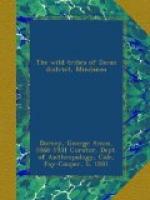“The Bagobos do not sacrifice any but old and decrepit or useless slaves captured from other tribes, but the Bilanes sacrifice even their own people.
“Being asked if it was customary to eat any portion of the body sacrificed, Ansig replied that it was not customary nor did he know of any case where such had occurred.
“The last sacrifice before this was held at Talun during the year of the drought (about 1905) when a Bilan slave, an old man who was paralyzed in one arm, was sacrificed by Datto Oling, his master.
“Asked if the sacrifice of an animal would not do as well as that of a human being, they said, ‘No, better to have no sacrifice at all.’
“They appeared utterly unconscious of having committed any crime, told their story with frankness, said it was a matter not talked about among their own people but that if we wanted to know the facts they would give them to the authorities. They claimed the offering of human sacrifices by their tribe to be an old custom and, as far as they knew the only way to appease the wrath of the evil spirits, but said if they were ordered to give the custom up they would do so even if the devil got them all.”
Then follows the statement of an eye-witness to the ceremony:
“My name is Modesta Barrera; I live in the town of Santa Cruz, my father being a Visayan, my mother a Bagobo. I cannot read or write, and I think that I am about twenty-three years old, although I am not certain on that point.
“On the 8th instant myself, Baon, Otoy, and Oton left Santa Cruz early in the morning to go to Talun, a day’s march from Santa Cruz, for the purpose of trading with the natives of Talun, and also to collect some debts which they owed Baon. We remained that night at Saculampula, near Talun, where Ungon and Ido, two Bagobos, live with their families. There we found two children the only persons at the house who informed us that we should go to the house of Ambing, at Talun, where we could sell our merchandise. On the morning of the 9th we got up about 7 or 8 o’clock and started for Ambing’s house. When within about an hour’s walk of the house, we found a great many people congregated together. We were told that a human sacrifice had just taken place and on approaching to discover what had happened, we saw a little boy about eight or nine years old, the upper half of whose body was suspended by the wrists to a tree, the lower half lying on the ground. The child had been thus tied up while alive and had been cut into two parts at the waist; this was about the position of the body when we saw it.
“Immediately about twenty persons began to chop the body into small pieces; and Ansig, the datto of Talun, came over to us and gave Baon two pieces of the victim’s hair attached to the scalp, which is a sign of the sacrifice. The victim was a slave owned and sacrificed by Datto Ansig. The first bolo cut which severs the body at the waist and which in this case we were told was done by Ansig is always performed by the person making the sacrifice. The people present were guests of Ansig and were not responsible for the killing, though it is the custom for the more favored ones to assist in chopping the victim into small pieces after death.”




